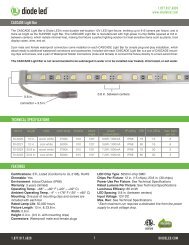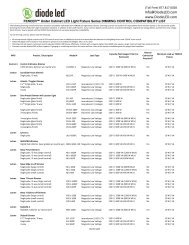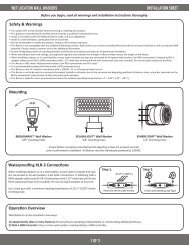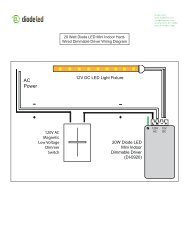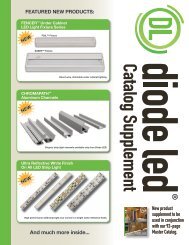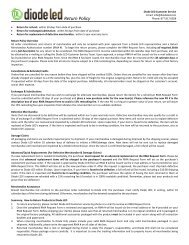to Download our 2012 Catalog - Diode LED
to Download our 2012 Catalog - Diode LED
to Download our 2012 Catalog - Diode LED
You also want an ePaper? Increase the reach of your titles
YUMPU automatically turns print PDFs into web optimized ePapers that Google loves.
The Benefits of <strong>LED</strong>s<br />
There are many reasons <strong>to</strong> choose <strong>LED</strong> lighting options, including personal<br />
preference, environmental responsibility, design elements, energy savings, and<br />
value. <strong>LED</strong>s provide some of the following benefits:<br />
Lifetime <strong>LED</strong> lights can last from 30,000 – 75,000 h<strong>our</strong>s (50,000<br />
h<strong>our</strong>s is the average) depending upon the quality, durability and use<br />
of the fixtures. With an average use of 6.5 h<strong>our</strong>s per day, this can<br />
amount <strong>to</strong> over 21 years of life!<br />
Energy-Efficient <strong>LED</strong> lights are the most efficient lights on the market.<br />
<strong>LED</strong>s use 1/3rd <strong>to</strong> 1/30th of the energy typically used with halogen<br />
and fluorescent lights.<br />
Durable <strong>LED</strong> lights are shockproof and will endure jarring and bumping,<br />
unlike their glass and filament counterparts.<br />
Cool In contrast <strong>to</strong> most light s<strong>our</strong>ces, <strong>LED</strong> lights emit very little heat<br />
in the form of infrared (IR) radiation, which can damage sensitive objects<br />
or fabrics. Waste energy is dispersed as heat through the base<br />
of the <strong>LED</strong>, rather than in<strong>to</strong> the air.<br />
Mercury-Free Unlike Compact Fluorescent Lights, <strong>LED</strong> lights contain<br />
no <strong>to</strong>xic components and are largely recyclable. And because they<br />
use less electricity than CFLs, less mercury is released in<strong>to</strong> the environment<br />
from power plants.<br />
Cost-Effective Although there is often a larger up-front cost, <strong>LED</strong><br />
lights save money over their lifetime in energy, maintenance and replacement<br />
cost, sometimes in just the first year of use.<br />
Healthy <strong>LED</strong> lights do not flicker, charge, emit ultraviolet (UV) radiation,<br />
hum or buzz.<br />
Safe <strong>LED</strong> lights are 12V or 24V DC low voltage lights and so they do<br />
not have the danger of shock like high voltage AC lighting.<br />
On/Off Time <strong>LED</strong> lights have the fastest on/off response of non-incandescent<br />
lighting, with no charge time.<br />
Focus The solid package of the <strong>LED</strong> can be designed <strong>to</strong> focus its<br />
light. Incandescent and fluorescent s<strong>our</strong>ces often require an external<br />
reflec<strong>to</strong>r <strong>to</strong> collect and direct light.<br />
Cycling <strong>LED</strong>s are ideal for use in applications that are subject <strong>to</strong><br />
frequent on-off cycling, unlike fluorescent lamps that burn out more<br />
quickly when cycled frequently, or HID lamps that require a long time<br />
before restarting.<br />
Size <strong>LED</strong> lights fit in<strong>to</strong> much smaller housings and fixtures that traditional<br />
lighting.<br />
Indirect Lighting Smaller applications allow many options for indirect<br />
light, which reduces eye strain and creates an evenly-lit, harmonious<br />
environment.<br />
The Advantages of Going Green<br />
WWW.DIODE<strong>LED</strong>.COM 1.877.817.6028<br />
87



